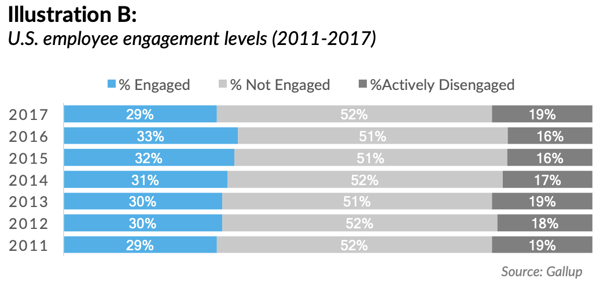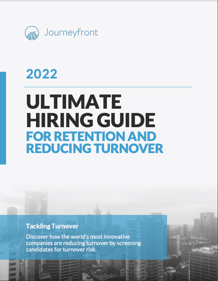One of the most common strategies for reducing turnover has been to invest in employee engagement initiatives. These efforts take many forms (engagement surveys, manager trainings, expensive company perks, etc.).
It is true that the more engaged an employee is the less likely they are to turnover. However, disengagement is only one of many factors that lead to turnover. What’s more important, efforts to reduce turnover by improving employee engagement have not had the impact many hoped they would. According to Bersin & Associates, U.S. investment in employee engagement initiatives grew from $750M / year in 2012 to $1.5B / year in 2017. Unfortunately, despite a 108% increase in investment, employee engagement levels have remained relatively flat over that same period.

Interested on how much turnover is costing your company? Click here to download our turnover calculator.
Why has such a massive investment yielded so little?
Certainly it’s not because employees aren’t trying. A recent study by the Conference Board found that 96% of employees actively strive to maintain a high level of engagement, despite struggling to do so (HBR 2018).
One possibility is that engagement has more to do with the internal motivators that drive a person rather than external influences put forth by the company. Indeed, many hiring managers have observed employees who seem to have brought their engagement with them to the job from day 1.
It’s very common to observe two workers in the same position and work environment who demonstrate very different levels of engagement. Externally, their situations are identical, but internally they have very different traits and past experiences driving them.
This certainly is supported by a recent meta study, which aggregated data from 114 independent employee surveys. The results of this study found that a whopping 50% of the variability in employee engagement was explained by a person’s personality (HBR 2018).
If there is anything you should takeaway from the above examples, it’s the following:
- First, nationwide efforts to reduce turnover through improved employee engagement have yielded little results.
- Second, research suggests that an employee’s level of engagement in a job is more likely the result of his / her own personal traits than any engagement initiatives undertaken by the company.
- Third, if the above is true, then the best way to increase employee engagement is to focus on hiring people more likely to be engaged.
- Fourth, if true for employee engagement, the same holds true for turnover. As we show in the turnover hiring guide below, the best way to reduce turnover is not to increase your investment in post-hire initiatives, but rather improve your hiring process in such a way that you are more effectively screening out those most likely to turnover.
Enjoy this article? This is a small portion of our hiring guide "The Ultimate Hiring Guide for Reducing Turnover." Take a look!
Click here to download the complete guide






